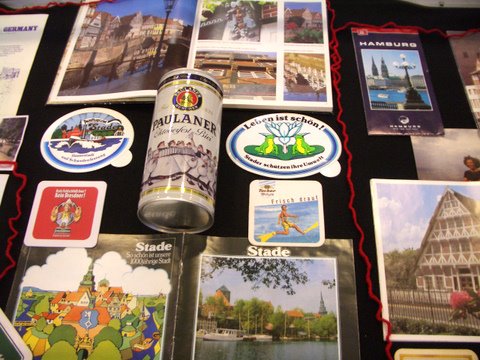

After 40 years, Professor Peter D.G. Brown has taken a step back to review his career and share it with the students he’s dedicated his life to.
His exhibit “What Remains: 40 Years of Teaching, Scholarship & Service at SUNY New Paltz, 1971-2011” opened at the Sojourner Truth Library on April 1. It is compiled of several encased exhibits, each chronicling a different area where Brown extended his inspired reach.
“I’d consider it a little retrospective look on 40 years of teaching and research,” said Brown.
He may have been a Professor of German Studies, but Brown made his presence known throughout the New Paltz community. The exhibit lines the entirety of the Library’s foyer, glass cases full of books, headlines, clippings and awards.
At the head of the exhibit stands a few of his most distinguished honors, including one from the German president Roman Herzog in 1999 for his service in fostering German-American relations and for his work as an editor. His series included “Studies in Modern German Literature,” “Studies in Jewish German History” and “Women in German Literature.” He began editing in 1985, his work eventually spanning 120 volumes.
“Editing helped me keep up with the scholarship in my field,” said Brown. “Students these days don’t appreciate books, the physicality, the layout and cover, books are losing out to Google and Wikipedia.”
He is quick to mention that he has pitched in on that front as well, writing the Wikipedia page for Oskar Panniza, a 19th century German author and playwright to whom Brown has dedicated three books, 40 years of research and a portion of the exhibit. Panizza received 93 counts of blasphemy, serving twelve months in jail for his controversial play “The Love Council.” He stood against the church, the Kaiser and was an advocate for free speech, said Brown.
In 1999, he was also awarded a Fulbright Grant to explore alternative energies; Germany is a true leader in wind and geo-thermal power, said Brown. His advocacy for opposition to Mid-Hudson Nuclear Power was in full swing between 1973 and 1980. He is surprised to see how “amazingly relevant” the subject has become as people re-evaluate our nuclear dependence after the ongoing tragedy in Japan.
His German-American relations also included a seven week study abroad program in Hamburg that he headed from 1973-1998. He talks about the excitement of visiting Berlin before and after the wall came down. While it took a large amount of work and energy it was worth the time he got to spend with students outside of class.
His concern for a positive learning experience can also be seen by his 1998 “Humanizing Humanities” campaign which turned the Humanities building into a home for all.
“Most classes in Humanites reminded me of a prison or a mental hospital,” said Brown. “There was nothing to look at, no art and no air conditioning — I thought someone was going to have a heart attack.”
In 1998 Brown assembled a task force for his “Humanizing Humanities” campaign and along with then president Roger Bowden put together a $6 to $7 million budget. They painted the exterior, added all the art pieces that adorn the walls today and put in new lighting. The air conditioning took three years and a separate petition before it was installed, costing two to three times what administration was looking to pay, said Brown.
All this and more can be viewed in his exhibit, which is a 50 foot stroll down memory lane. Students walking along the exhibit were impressed by the professors extensive resumė of activism.
“It really is inspiring,” said Josh Simpson, a second-year student. “I hope that, whatever I do in my professional career, I can make a fraction of the difference he made. He didn’t let his title as professor limit his ambition.”
Brown assures that none of this is an attempt to toot his own horn, but rather to show students and faculty that we can make a difference beyond our roles. He said his one hope is that he has left New Paltz a better place than he found it, joking that he will probably be viewed as a footnote to Oskar Panniza or as the bringer of air conditioning to Humanities.
“I hope to be remembered as a team player, who worked well with others. That’s how you get things done,” said Brown. “I’m going to miss my students, it will be hard to leave. New Paltz is a great place and that is why students want to come here.”
